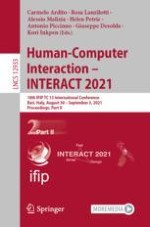The five-volume set LNCS 12932-12936 constitutes the proceedings of the 18th IFIP TC 13 International Conference on Human-Computer Interaction, INTERACT 2021, held in Bari, Italy, in August/September 2021.
The total of 105 full papers presented together with 72 short papers and 70 other papers in these books was carefully reviewed and selected from 680 submissions. The contributions are organized in topical sections named:
Part I: affective computing; assistive technology for cognition and neurodevelopment disorders; assistive technology for mobility and rehabilitation; assistive technology for visually impaired; augmented reality; computer supported cooperative work.
Part II: COVID-19 & HCI; croudsourcing methods in HCI; design for automotive interfaces; design methods; designing for smart devices & IoT; designing for the elderly and accessibility; education and HCI; experiencing sound and music technologies; explainable AI.
Part III: games and gamification; gesture interaction; human-centered AI; human-centered development of sustainable technology; human-robot interaction; information visualization; interactive design and cultural development.
Part IV: interaction techniques; interaction with conversational agents; interaction with mobile devices; methods for user studies; personalization and recommender systems; social networks and social media; tangible interaction; usable security.
Part V: user studies; virtual reality; courses; industrial experiences; interactive demos; panels; posters; workshops.
The chapter ‘Stress Out: Translating Real-World Stressors into Audio-Visual Stress Cues in VR for Police Training’ is open access under a CC BY 4.0 license at link.springer.com.
The chapter ‘WhatsApp in Politics?! Collaborative Tools Shifting Boundaries’ is open access under a CC BY 4.0 license at link.springer.com.
